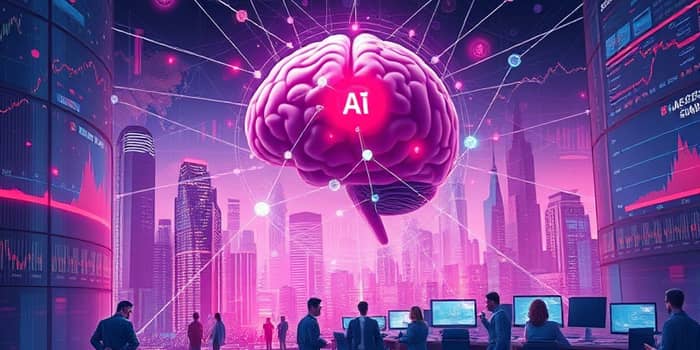
In 2025, AI has matured from a novel technology to a strategic imperative for businesses and governments worldwide. Across continents, boardrooms and policy forums are reorienting priorities to accommodate the rapid advances in machine learning, natural language processing, and generative models.
This transformation underscores AI’s role as a dominant driver of market trends, influencing stock valuations, M&A strategies, and competitive positioning in every major industry.
The global artificial intelligence market is on a relentless upward trajectory. Current estimates place its value between $391 billion and $758 billion for 2025, with an anticipated compound annual growth rate of 19.2%–36.6% through 2034.
Regional dynamics vary: North America leads with extensive research hubs, robust infrastructure, and favorable regulations, driving an early 2025 valuation exceeding $200 billion. China follows closely, backed by a $150 billion national AI plan, while Europe accelerates toward near-universal adoption by standardizing AI governance and funding collaborative research networks.
By 2030, AI is forecast to add $15.7 trillion to the global economy, delivering productivity gains, cost savings, and unlocking new revenue streams for companies structural realignments in labor markets, supply chains, and service models.
Finance has emerged as a showcase for AI’s potential. Over 65% of financial institutions employ machine learning algorithms for real-time risk assessment, algorithmic trading, and fraud detection. Robo-advisors now manage billions in assets, democratizing portfolio management and reducing fees.
In healthcare, diagnostic support systems analyze imaging data with speeds and accuracy levels rivaling expert clinicians. AI-driven drug discovery platforms have accelerated candidate screening, while telemedicine solutions leverage conversational agents to triage symptoms and schedule care. The healthcare AI market alone is projected to exceed $187.95 billion by 2030.
Retailers deploy AI for demand forecasting, dynamic pricing, and personalized marketing campaigns. Behind the scenes, supply chain algorithms optimize inventory flow, reducing stockouts and waste. Entertainment platforms generate over $1 billion yearly through personalized recommendation engines powered by AI, while gaming studios use procedural generation to create expansive, adaptive virtual worlds.
The automotive sector is witnessing a revolution as manufacturers integrate advanced driver-assistance systems and test fully autonomous fleets. Machine learning models interpret sensor data from LiDAR, radar, and cameras, improving safety and fuel efficiency. Meanwhile, voice assistants embedded in vehicles and smart devices exceed eight billion active deployments globally, guiding users through navigation, entertainment, and home automation.
AI’s impact on employment is double-edged. The World Economic Forum anticipates that while 85 million jobs may be displaced by automation, approximately 97 million new roles will emerge, focused on AI maintenance, data annotation, and model supervision.
Industrial-scale reskilling programs are proliferating. Governments, universities, and corporations partner to offer certification courses, boot camps, and apprenticeships. These initiatives recognize that large-scale reskilling is needed to empower workers for roles in data science, AI ethics, and system integration.
Competition for AI talent has intensified into a global arms race. The United States offers research grants and startup incentives, China builds dedicated AI industrial parks, and the European Union funds cross-border innovation clusters. Companies are also investing in internal training and knowledge-sharing networks to develop proprietary competencies.
Core enabling technologies underpinning AI include high-performance GPUs, custom AI accelerators, and expansive cloud infrastructure. Market analysts forecast AI chip revenues exceeding $80 billion by 2027, with a trajectory to surpass $400 billion by 2030 as companies invest heavily in on-premise data centers and edge computing hardware.
Cloud providers increasingly bundle AI-as-a-Service offerings, democratizing access to powerful models and analytics tools. This shift allows startups and midsize firms to integrate AI capabilities without upfront capital expenditures, fostering innovation across verticals.
Venture capital and corporate investment have poured into generative AI platforms, responsible AI tools, and specialized hardware startups. The surge in capital allocation underscores sustained confidence in AI’s capacity to drive revenue growth, cost reduction, and competitive edge.
Rapid AI adoption raises complex ethical and governance questions. Algorithmic bias can perpetuate social inequities, while opaque “black box” models challenge transparency and accountability. Environmental concerns also surface as data centers demand growing energy and water resources.
Stakeholders must commit to balancing innovation and responsibility by establishing ethical guidelines, investing in explainable AI research, and collaborating on international standards. Only through shared oversight can AI’s benefits be maximized while risks are mitigated.
Looking toward 2030, emergent trends such as edge AI, federated learning, and neuromorphic computing promise to decentralize intelligence closer to data sources, enhancing privacy and reducing latency. AI-driven sustainability initiatives, including precision agriculture and carbon footprint optimization, will address global environmental challenges.
Open-source AI frameworks and community-driven research are democratizing development, enabling citizen data scientists to contribute innovations. Governments are crafting frameworks to ensure equitable access to AI benefits, aiming to narrow digital divides and support inclusive growth.
The next five years will cement AI’s status as a foundational technology. Companies that invest early in robust data architectures, cultivate cross-disciplinary talent, and adhere to ethical standards will outpace competitors in revenue growth and market share. This era demands agility, foresight, and a commitment to continuous learning.
The AI revolution is not a distant horizon—it is unfolding now. Every stakeholder, from startup founders to heads of state, must align strategy with the accelerating pace of innovation. By embracing AI’s potential and addressing its challenges head-on, we stand at the threshold of a new era of global prosperity.
As markets adjust to this relentless wave of change, one truth becomes clear: exponential AI adoption means new possibilities for industries, economies, and societies around the world.
References













